Analyzing the Vulnerability Stress Paradigm: Mental Health Impact
VerifiedAdded on 2023/06/03
|11
|2193
|237
Essay
AI Summary
This essay provides a detailed analysis of the Vulnerability Stress Paradigm, which posits that stress, biological vulnerabilities, and protective factors interact to influence the development of mental disorders. It discusses how biological and genetic predispositions, coupled with environmental stressors, can lead to conditions like schizophrenia and co-morbid substance abuse disorders. The essay also explores the role of protective factors, such as supportive environments and effective coping skills, in mitigating these vulnerabilities. Furthermore, it examines interventions aimed at reducing biological vulnerability, such as medication and avoiding substance abuse, and strategies for enhancing resilience against stress. The conclusion emphasizes the importance of managing environmental factors and promoting protective mechanisms to improve the long-term outcomes and quality of life for individuals with mental disorders. Desklib offers a range of resources, including past papers and solved assignments, to support students in understanding complex topics like the Vulnerability Stress Paradigm.
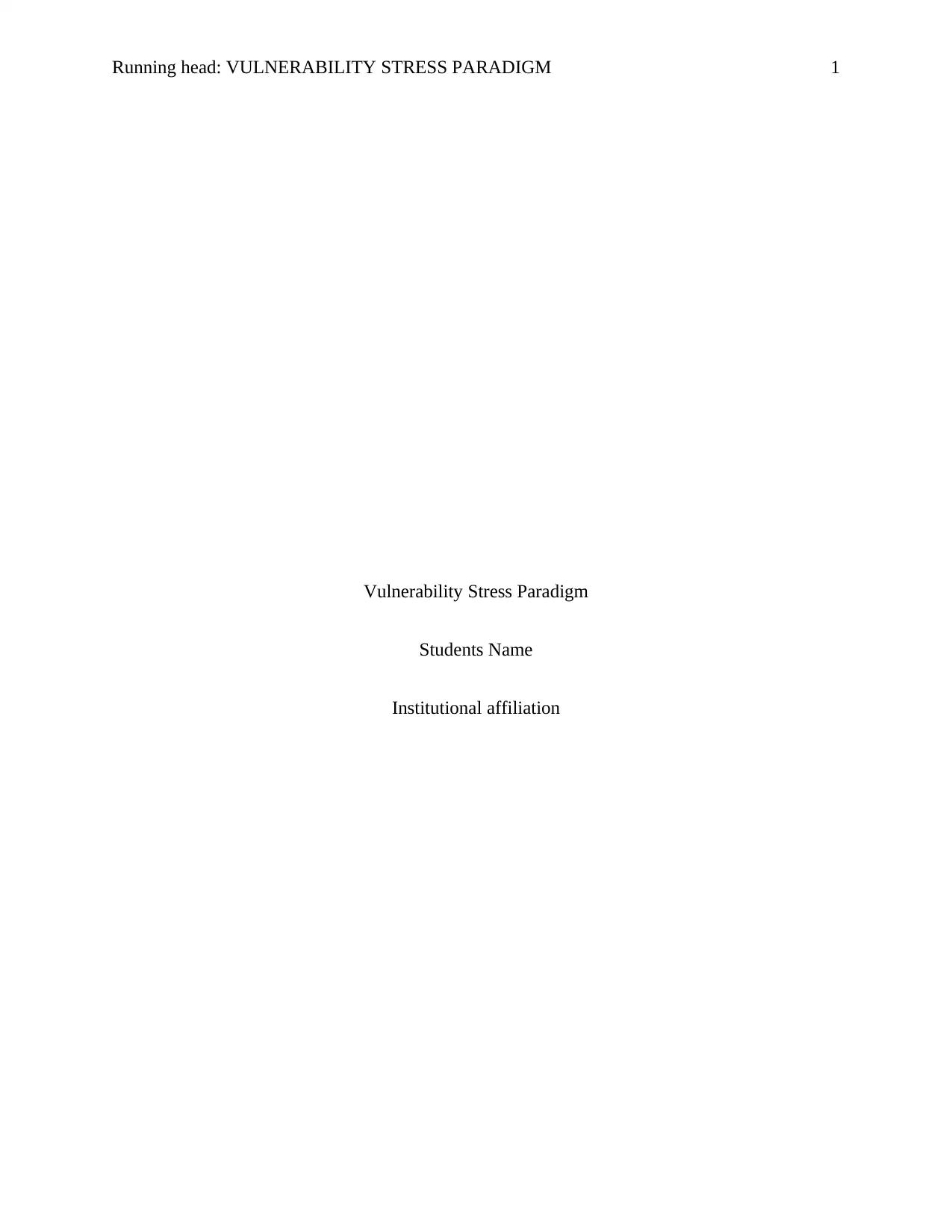
Running head: VULNERABILITY STRESS PARADIGM 1
Vulnerability Stress Paradigm
Students Name
Institutional affiliation
Vulnerability Stress Paradigm
Students Name
Institutional affiliation
Paraphrase This Document
Need a fresh take? Get an instant paraphrase of this document with our AI Paraphraser
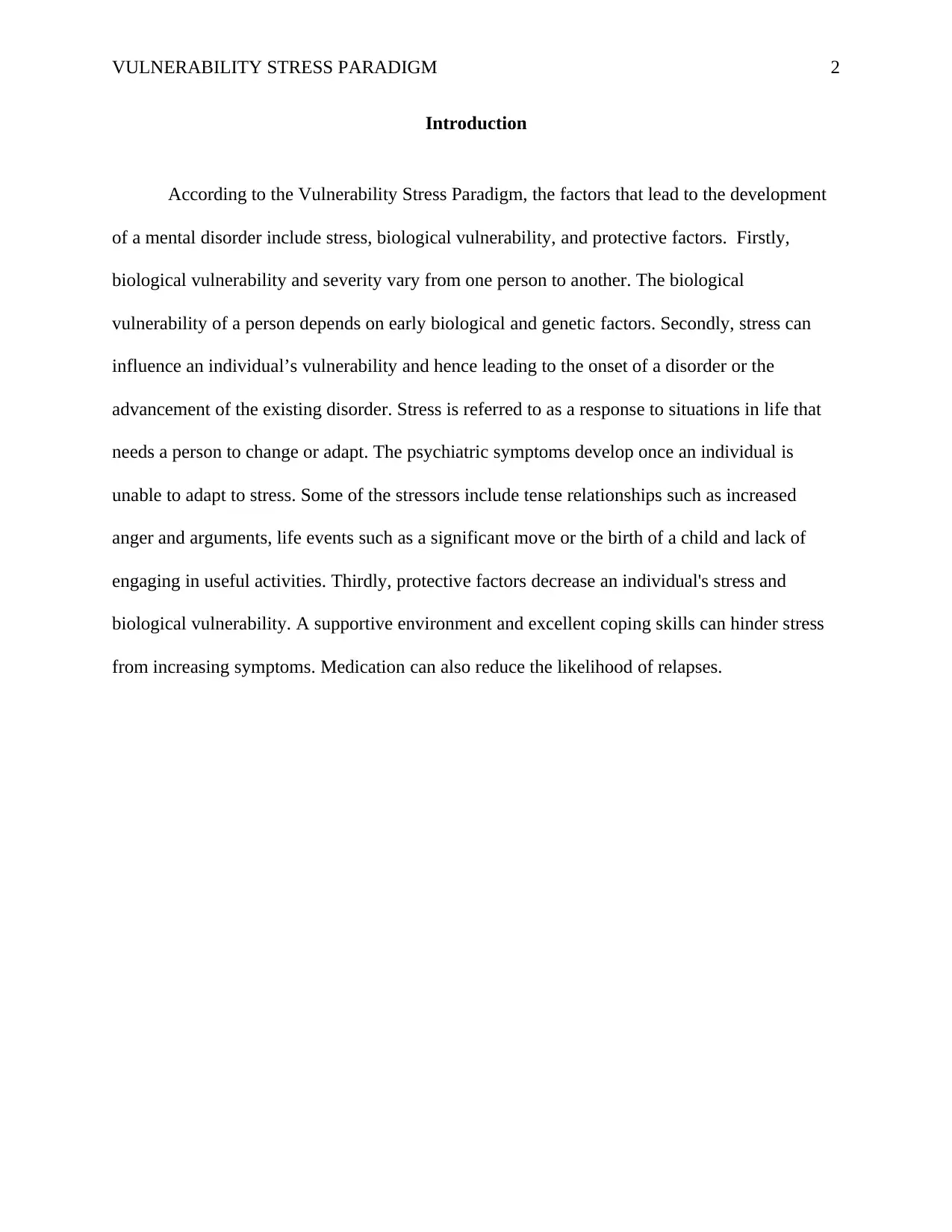
VULNERABILITY STRESS PARADIGM 2
Introduction
According to the Vulnerability Stress Paradigm, the factors that lead to the development
of a mental disorder include stress, biological vulnerability, and protective factors. Firstly,
biological vulnerability and severity vary from one person to another. The biological
vulnerability of a person depends on early biological and genetic factors. Secondly, stress can
influence an individual’s vulnerability and hence leading to the onset of a disorder or the
advancement of the existing disorder. Stress is referred to as a response to situations in life that
needs a person to change or adapt. The psychiatric symptoms develop once an individual is
unable to adapt to stress. Some of the stressors include tense relationships such as increased
anger and arguments, life events such as a significant move or the birth of a child and lack of
engaging in useful activities. Thirdly, protective factors decrease an individual's stress and
biological vulnerability. A supportive environment and excellent coping skills can hinder stress
from increasing symptoms. Medication can also reduce the likelihood of relapses.
Introduction
According to the Vulnerability Stress Paradigm, the factors that lead to the development
of a mental disorder include stress, biological vulnerability, and protective factors. Firstly,
biological vulnerability and severity vary from one person to another. The biological
vulnerability of a person depends on early biological and genetic factors. Secondly, stress can
influence an individual’s vulnerability and hence leading to the onset of a disorder or the
advancement of the existing disorder. Stress is referred to as a response to situations in life that
needs a person to change or adapt. The psychiatric symptoms develop once an individual is
unable to adapt to stress. Some of the stressors include tense relationships such as increased
anger and arguments, life events such as a significant move or the birth of a child and lack of
engaging in useful activities. Thirdly, protective factors decrease an individual's stress and
biological vulnerability. A supportive environment and excellent coping skills can hinder stress
from increasing symptoms. Medication can also reduce the likelihood of relapses.
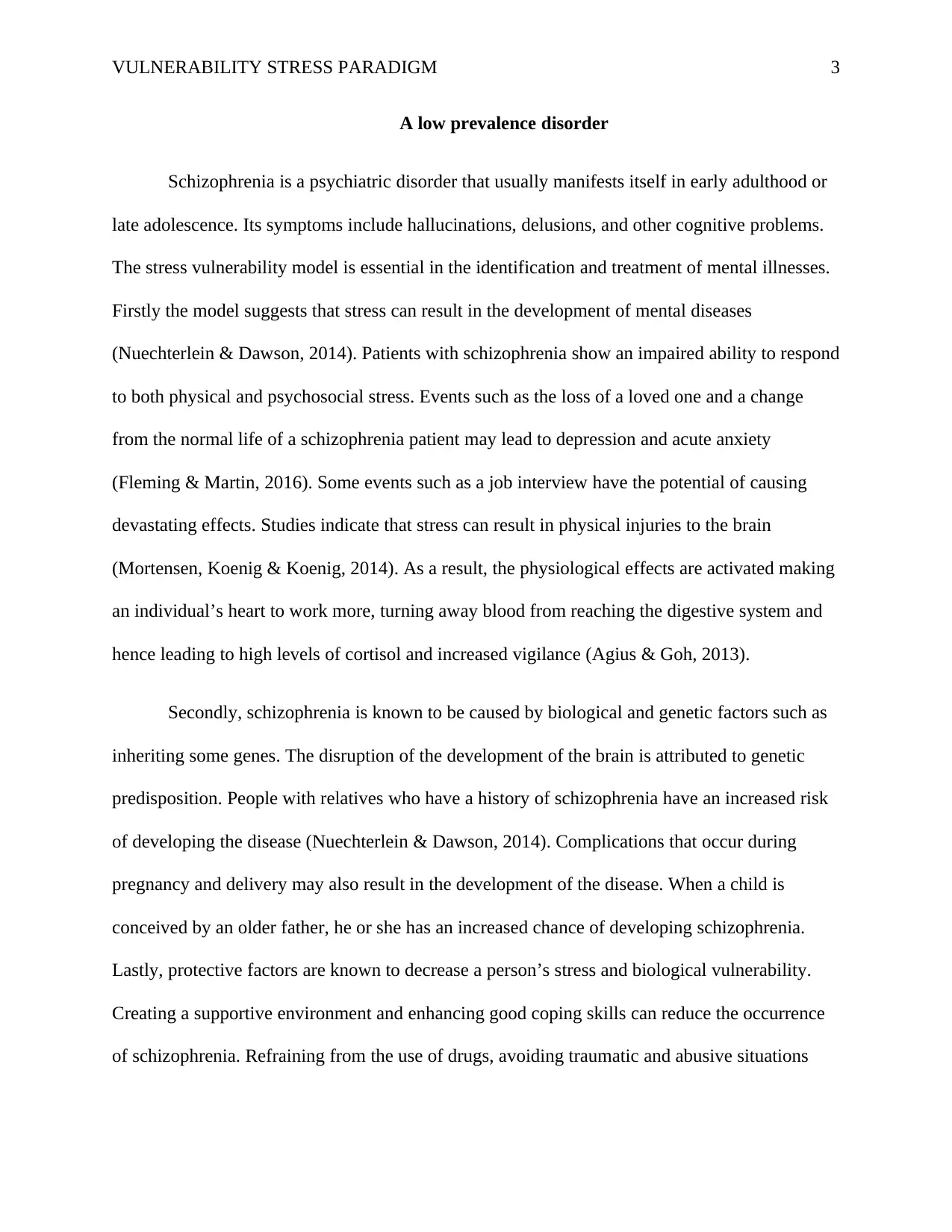
VULNERABILITY STRESS PARADIGM 3
A low prevalence disorder
Schizophrenia is a psychiatric disorder that usually manifests itself in early adulthood or
late adolescence. Its symptoms include hallucinations, delusions, and other cognitive problems.
The stress vulnerability model is essential in the identification and treatment of mental illnesses.
Firstly the model suggests that stress can result in the development of mental diseases
(Nuechterlein & Dawson, 2014). Patients with schizophrenia show an impaired ability to respond
to both physical and psychosocial stress. Events such as the loss of a loved one and a change
from the normal life of a schizophrenia patient may lead to depression and acute anxiety
(Fleming & Martin, 2016). Some events such as a job interview have the potential of causing
devastating effects. Studies indicate that stress can result in physical injuries to the brain
(Mortensen, Koenig & Koenig, 2014). As a result, the physiological effects are activated making
an individual’s heart to work more, turning away blood from reaching the digestive system and
hence leading to high levels of cortisol and increased vigilance (Agius & Goh, 2013).
Secondly, schizophrenia is known to be caused by biological and genetic factors such as
inheriting some genes. The disruption of the development of the brain is attributed to genetic
predisposition. People with relatives who have a history of schizophrenia have an increased risk
of developing the disease (Nuechterlein & Dawson, 2014). Complications that occur during
pregnancy and delivery may also result in the development of the disease. When a child is
conceived by an older father, he or she has an increased chance of developing schizophrenia.
Lastly, protective factors are known to decrease a person’s stress and biological vulnerability.
Creating a supportive environment and enhancing good coping skills can reduce the occurrence
of schizophrenia. Refraining from the use of drugs, avoiding traumatic and abusive situations
A low prevalence disorder
Schizophrenia is a psychiatric disorder that usually manifests itself in early adulthood or
late adolescence. Its symptoms include hallucinations, delusions, and other cognitive problems.
The stress vulnerability model is essential in the identification and treatment of mental illnesses.
Firstly the model suggests that stress can result in the development of mental diseases
(Nuechterlein & Dawson, 2014). Patients with schizophrenia show an impaired ability to respond
to both physical and psychosocial stress. Events such as the loss of a loved one and a change
from the normal life of a schizophrenia patient may lead to depression and acute anxiety
(Fleming & Martin, 2016). Some events such as a job interview have the potential of causing
devastating effects. Studies indicate that stress can result in physical injuries to the brain
(Mortensen, Koenig & Koenig, 2014). As a result, the physiological effects are activated making
an individual’s heart to work more, turning away blood from reaching the digestive system and
hence leading to high levels of cortisol and increased vigilance (Agius & Goh, 2013).
Secondly, schizophrenia is known to be caused by biological and genetic factors such as
inheriting some genes. The disruption of the development of the brain is attributed to genetic
predisposition. People with relatives who have a history of schizophrenia have an increased risk
of developing the disease (Nuechterlein & Dawson, 2014). Complications that occur during
pregnancy and delivery may also result in the development of the disease. When a child is
conceived by an older father, he or she has an increased chance of developing schizophrenia.
Lastly, protective factors are known to decrease a person’s stress and biological vulnerability.
Creating a supportive environment and enhancing good coping skills can reduce the occurrence
of schizophrenia. Refraining from the use of drugs, avoiding traumatic and abusive situations
⊘ This is a preview!⊘
Do you want full access?
Subscribe today to unlock all pages.

Trusted by 1+ million students worldwide
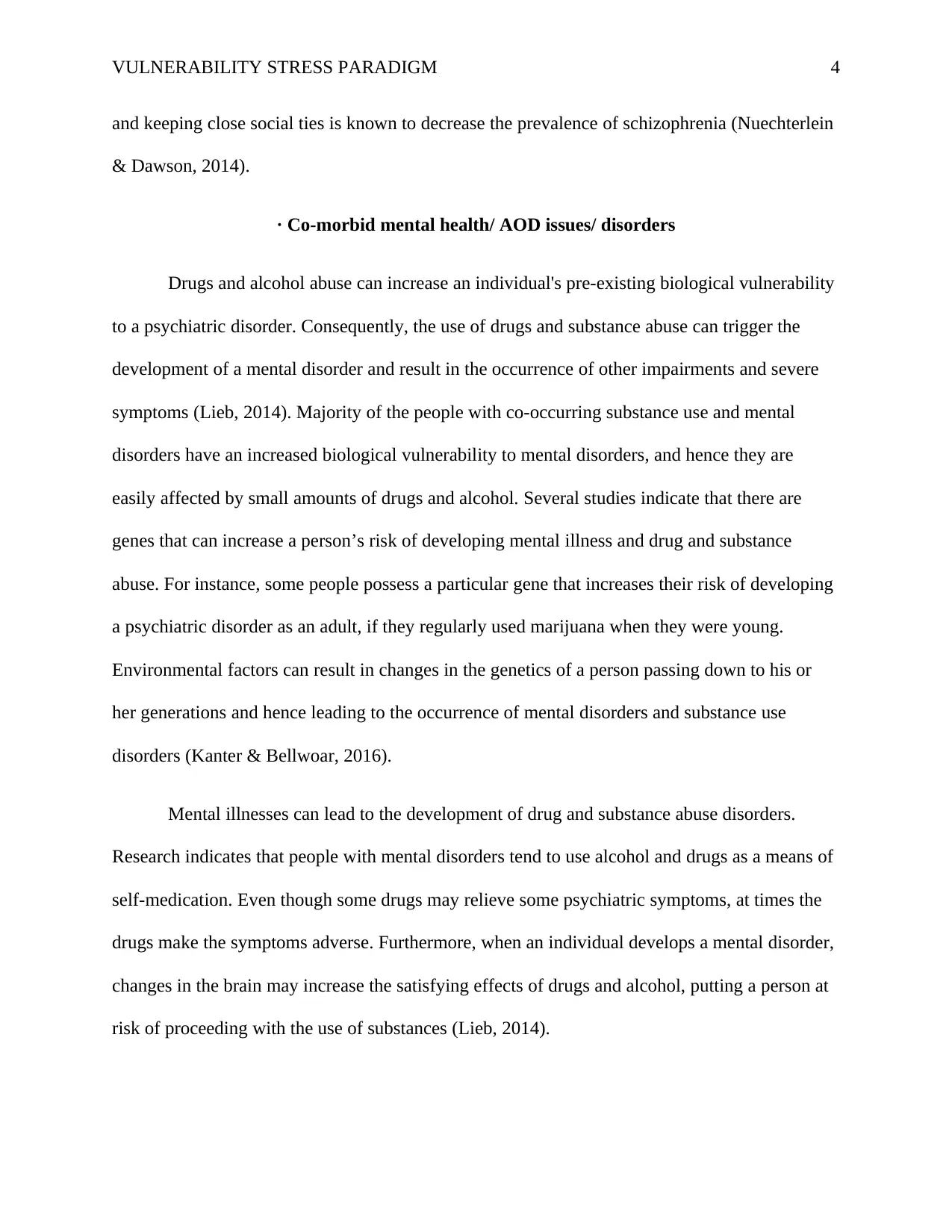
VULNERABILITY STRESS PARADIGM 4
and keeping close social ties is known to decrease the prevalence of schizophrenia (Nuechterlein
& Dawson, 2014).
· Co-morbid mental health/ AOD issues/ disorders
Drugs and alcohol abuse can increase an individual's pre-existing biological vulnerability
to a psychiatric disorder. Consequently, the use of drugs and substance abuse can trigger the
development of a mental disorder and result in the occurrence of other impairments and severe
symptoms (Lieb, 2014). Majority of the people with co-occurring substance use and mental
disorders have an increased biological vulnerability to mental disorders, and hence they are
easily affected by small amounts of drugs and alcohol. Several studies indicate that there are
genes that can increase a person’s risk of developing mental illness and drug and substance
abuse. For instance, some people possess a particular gene that increases their risk of developing
a psychiatric disorder as an adult, if they regularly used marijuana when they were young.
Environmental factors can result in changes in the genetics of a person passing down to his or
her generations and hence leading to the occurrence of mental disorders and substance use
disorders (Kanter & Bellwoar, 2016).
Mental illnesses can lead to the development of drug and substance abuse disorders.
Research indicates that people with mental disorders tend to use alcohol and drugs as a means of
self-medication. Even though some drugs may relieve some psychiatric symptoms, at times the
drugs make the symptoms adverse. Furthermore, when an individual develops a mental disorder,
changes in the brain may increase the satisfying effects of drugs and alcohol, putting a person at
risk of proceeding with the use of substances (Lieb, 2014).
and keeping close social ties is known to decrease the prevalence of schizophrenia (Nuechterlein
& Dawson, 2014).
· Co-morbid mental health/ AOD issues/ disorders
Drugs and alcohol abuse can increase an individual's pre-existing biological vulnerability
to a psychiatric disorder. Consequently, the use of drugs and substance abuse can trigger the
development of a mental disorder and result in the occurrence of other impairments and severe
symptoms (Lieb, 2014). Majority of the people with co-occurring substance use and mental
disorders have an increased biological vulnerability to mental disorders, and hence they are
easily affected by small amounts of drugs and alcohol. Several studies indicate that there are
genes that can increase a person’s risk of developing mental illness and drug and substance
abuse. For instance, some people possess a particular gene that increases their risk of developing
a psychiatric disorder as an adult, if they regularly used marijuana when they were young.
Environmental factors can result in changes in the genetics of a person passing down to his or
her generations and hence leading to the occurrence of mental disorders and substance use
disorders (Kanter & Bellwoar, 2016).
Mental illnesses can lead to the development of drug and substance abuse disorders.
Research indicates that people with mental disorders tend to use alcohol and drugs as a means of
self-medication. Even though some drugs may relieve some psychiatric symptoms, at times the
drugs make the symptoms adverse. Furthermore, when an individual develops a mental disorder,
changes in the brain may increase the satisfying effects of drugs and alcohol, putting a person at
risk of proceeding with the use of substances (Lieb, 2014).
Paraphrase This Document
Need a fresh take? Get an instant paraphrase of this document with our AI Paraphraser
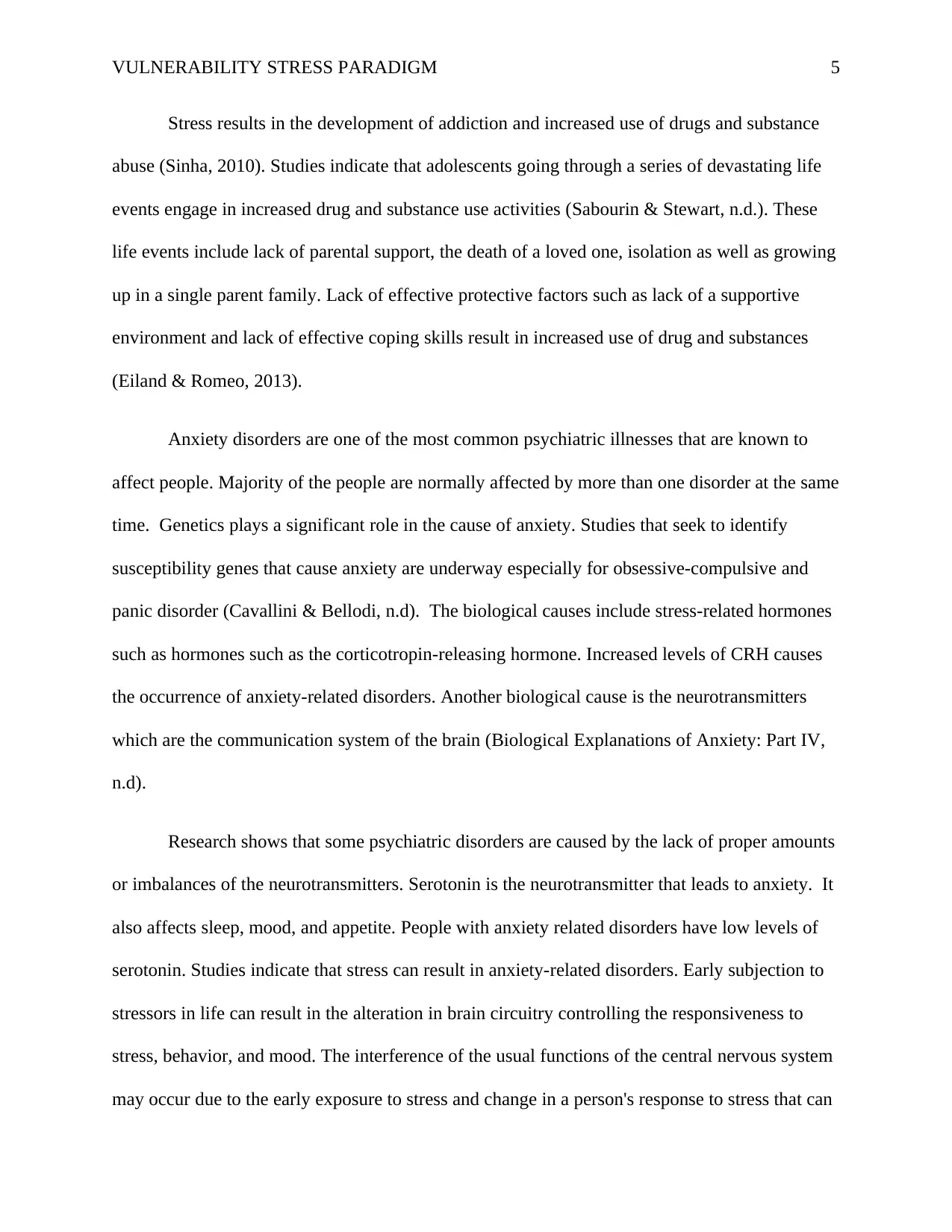
VULNERABILITY STRESS PARADIGM 5
Stress results in the development of addiction and increased use of drugs and substance
abuse (Sinha, 2010). Studies indicate that adolescents going through a series of devastating life
events engage in increased drug and substance use activities (Sabourin & Stewart, n.d.). These
life events include lack of parental support, the death of a loved one, isolation as well as growing
up in a single parent family. Lack of effective protective factors such as lack of a supportive
environment and lack of effective coping skills result in increased use of drug and substances
(Eiland & Romeo, 2013).
Anxiety disorders are one of the most common psychiatric illnesses that are known to
affect people. Majority of the people are normally affected by more than one disorder at the same
time. Genetics plays a significant role in the cause of anxiety. Studies that seek to identify
susceptibility genes that cause anxiety are underway especially for obsessive-compulsive and
panic disorder (Cavallini & Bellodi, n.d). The biological causes include stress-related hormones
such as hormones such as the corticotropin-releasing hormone. Increased levels of CRH causes
the occurrence of anxiety-related disorders. Another biological cause is the neurotransmitters
which are the communication system of the brain (Biological Explanations of Anxiety: Part IV,
n.d).
Research shows that some psychiatric disorders are caused by the lack of proper amounts
or imbalances of the neurotransmitters. Serotonin is the neurotransmitter that leads to anxiety. It
also affects sleep, mood, and appetite. People with anxiety related disorders have low levels of
serotonin. Studies indicate that stress can result in anxiety-related disorders. Early subjection to
stressors in life can result in the alteration in brain circuitry controlling the responsiveness to
stress, behavior, and mood. The interference of the usual functions of the central nervous system
may occur due to the early exposure to stress and change in a person's response to stress that can
Stress results in the development of addiction and increased use of drugs and substance
abuse (Sinha, 2010). Studies indicate that adolescents going through a series of devastating life
events engage in increased drug and substance use activities (Sabourin & Stewart, n.d.). These
life events include lack of parental support, the death of a loved one, isolation as well as growing
up in a single parent family. Lack of effective protective factors such as lack of a supportive
environment and lack of effective coping skills result in increased use of drug and substances
(Eiland & Romeo, 2013).
Anxiety disorders are one of the most common psychiatric illnesses that are known to
affect people. Majority of the people are normally affected by more than one disorder at the same
time. Genetics plays a significant role in the cause of anxiety. Studies that seek to identify
susceptibility genes that cause anxiety are underway especially for obsessive-compulsive and
panic disorder (Cavallini & Bellodi, n.d). The biological causes include stress-related hormones
such as hormones such as the corticotropin-releasing hormone. Increased levels of CRH causes
the occurrence of anxiety-related disorders. Another biological cause is the neurotransmitters
which are the communication system of the brain (Biological Explanations of Anxiety: Part IV,
n.d).
Research shows that some psychiatric disorders are caused by the lack of proper amounts
or imbalances of the neurotransmitters. Serotonin is the neurotransmitter that leads to anxiety. It
also affects sleep, mood, and appetite. People with anxiety related disorders have low levels of
serotonin. Studies indicate that stress can result in anxiety-related disorders. Early subjection to
stressors in life can result in the alteration in brain circuitry controlling the responsiveness to
stress, behavior, and mood. The interference of the usual functions of the central nervous system
may occur due to the early exposure to stress and change in a person's response to stress that can
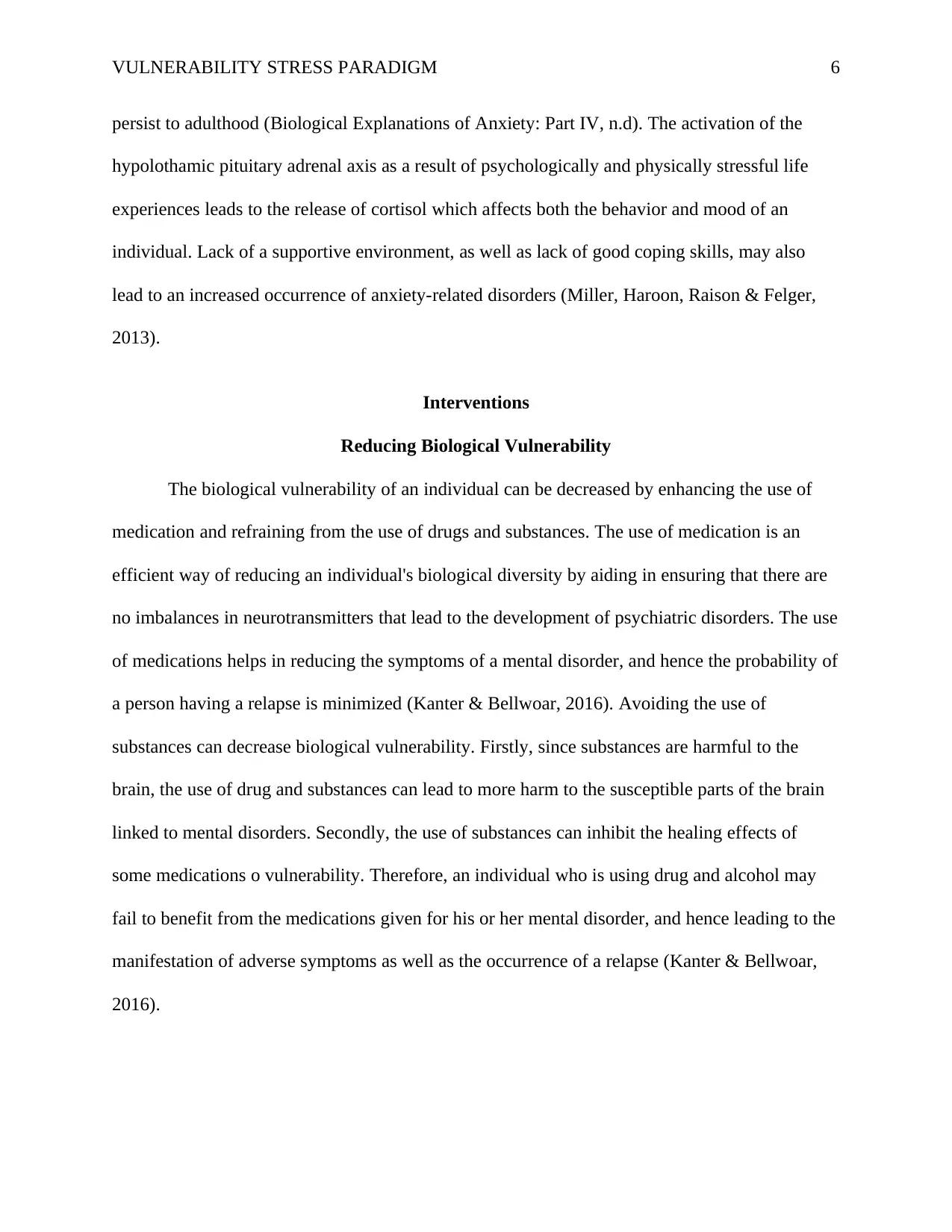
VULNERABILITY STRESS PARADIGM 6
persist to adulthood (Biological Explanations of Anxiety: Part IV, n.d). The activation of the
hypolothamic pituitary adrenal axis as a result of psychologically and physically stressful life
experiences leads to the release of cortisol which affects both the behavior and mood of an
individual. Lack of a supportive environment, as well as lack of good coping skills, may also
lead to an increased occurrence of anxiety-related disorders (Miller, Haroon, Raison & Felger,
2013).
Interventions
Reducing Biological Vulnerability
The biological vulnerability of an individual can be decreased by enhancing the use of
medication and refraining from the use of drugs and substances. The use of medication is an
efficient way of reducing an individual's biological diversity by aiding in ensuring that there are
no imbalances in neurotransmitters that lead to the development of psychiatric disorders. The use
of medications helps in reducing the symptoms of a mental disorder, and hence the probability of
a person having a relapse is minimized (Kanter & Bellwoar, 2016). Avoiding the use of
substances can decrease biological vulnerability. Firstly, since substances are harmful to the
brain, the use of drug and substances can lead to more harm to the susceptible parts of the brain
linked to mental disorders. Secondly, the use of substances can inhibit the healing effects of
some medications o vulnerability. Therefore, an individual who is using drug and alcohol may
fail to benefit from the medications given for his or her mental disorder, and hence leading to the
manifestation of adverse symptoms as well as the occurrence of a relapse (Kanter & Bellwoar,
2016).
persist to adulthood (Biological Explanations of Anxiety: Part IV, n.d). The activation of the
hypolothamic pituitary adrenal axis as a result of psychologically and physically stressful life
experiences leads to the release of cortisol which affects both the behavior and mood of an
individual. Lack of a supportive environment, as well as lack of good coping skills, may also
lead to an increased occurrence of anxiety-related disorders (Miller, Haroon, Raison & Felger,
2013).
Interventions
Reducing Biological Vulnerability
The biological vulnerability of an individual can be decreased by enhancing the use of
medication and refraining from the use of drugs and substances. The use of medication is an
efficient way of reducing an individual's biological diversity by aiding in ensuring that there are
no imbalances in neurotransmitters that lead to the development of psychiatric disorders. The use
of medications helps in reducing the symptoms of a mental disorder, and hence the probability of
a person having a relapse is minimized (Kanter & Bellwoar, 2016). Avoiding the use of
substances can decrease biological vulnerability. Firstly, since substances are harmful to the
brain, the use of drug and substances can lead to more harm to the susceptible parts of the brain
linked to mental disorders. Secondly, the use of substances can inhibit the healing effects of
some medications o vulnerability. Therefore, an individual who is using drug and alcohol may
fail to benefit from the medications given for his or her mental disorder, and hence leading to the
manifestation of adverse symptoms as well as the occurrence of a relapse (Kanter & Bellwoar,
2016).
⊘ This is a preview!⊘
Do you want full access?
Subscribe today to unlock all pages.

Trusted by 1+ million students worldwide
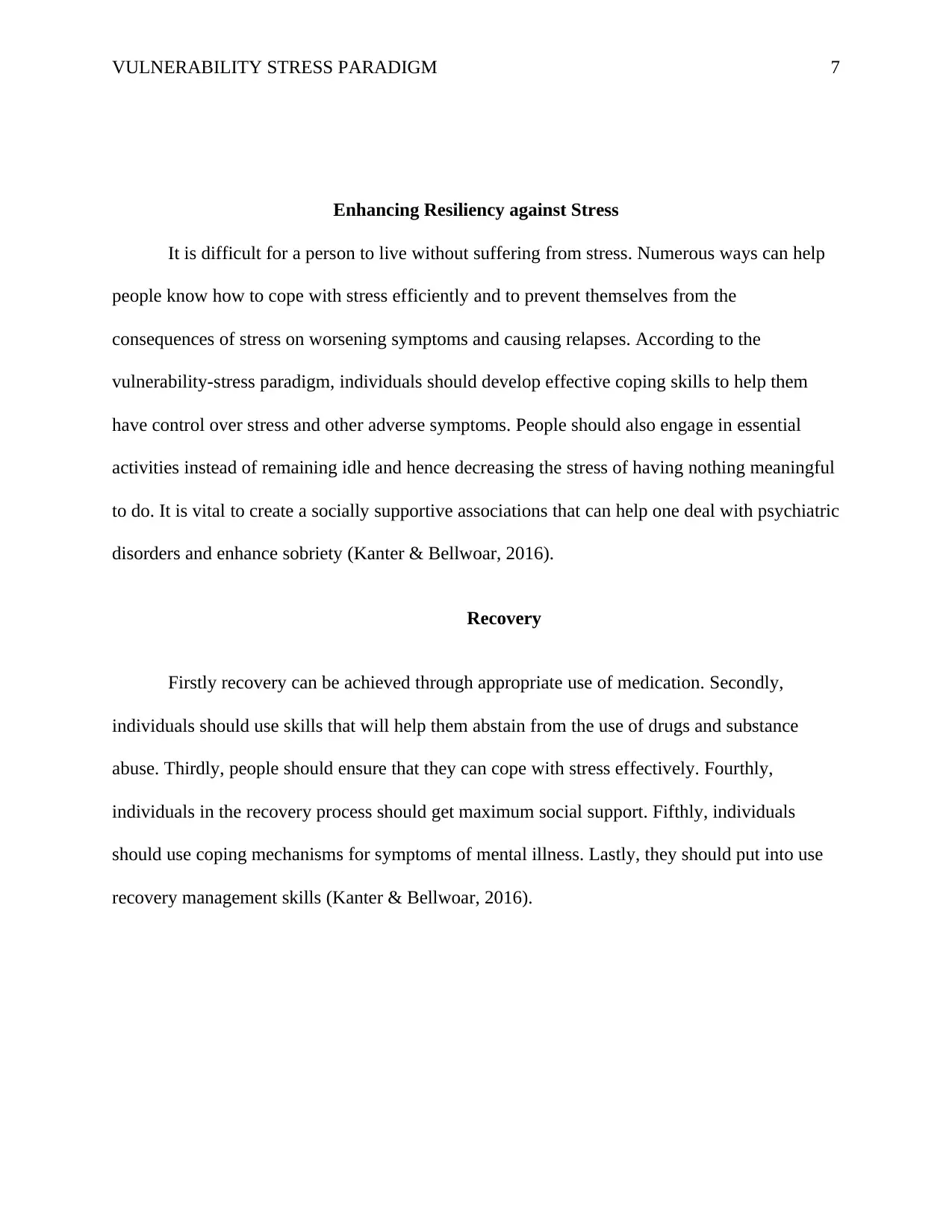
VULNERABILITY STRESS PARADIGM 7
Enhancing Resiliency against Stress
It is difficult for a person to live without suffering from stress. Numerous ways can help
people know how to cope with stress efficiently and to prevent themselves from the
consequences of stress on worsening symptoms and causing relapses. According to the
vulnerability-stress paradigm, individuals should develop effective coping skills to help them
have control over stress and other adverse symptoms. People should also engage in essential
activities instead of remaining idle and hence decreasing the stress of having nothing meaningful
to do. It is vital to create a socially supportive associations that can help one deal with psychiatric
disorders and enhance sobriety (Kanter & Bellwoar, 2016).
Recovery
Firstly recovery can be achieved through appropriate use of medication. Secondly,
individuals should use skills that will help them abstain from the use of drugs and substance
abuse. Thirdly, people should ensure that they can cope with stress effectively. Fourthly,
individuals in the recovery process should get maximum social support. Fifthly, individuals
should use coping mechanisms for symptoms of mental illness. Lastly, they should put into use
recovery management skills (Kanter & Bellwoar, 2016).
Enhancing Resiliency against Stress
It is difficult for a person to live without suffering from stress. Numerous ways can help
people know how to cope with stress efficiently and to prevent themselves from the
consequences of stress on worsening symptoms and causing relapses. According to the
vulnerability-stress paradigm, individuals should develop effective coping skills to help them
have control over stress and other adverse symptoms. People should also engage in essential
activities instead of remaining idle and hence decreasing the stress of having nothing meaningful
to do. It is vital to create a socially supportive associations that can help one deal with psychiatric
disorders and enhance sobriety (Kanter & Bellwoar, 2016).
Recovery
Firstly recovery can be achieved through appropriate use of medication. Secondly,
individuals should use skills that will help them abstain from the use of drugs and substance
abuse. Thirdly, people should ensure that they can cope with stress effectively. Fourthly,
individuals in the recovery process should get maximum social support. Fifthly, individuals
should use coping mechanisms for symptoms of mental illness. Lastly, they should put into use
recovery management skills (Kanter & Bellwoar, 2016).
Paraphrase This Document
Need a fresh take? Get an instant paraphrase of this document with our AI Paraphraser
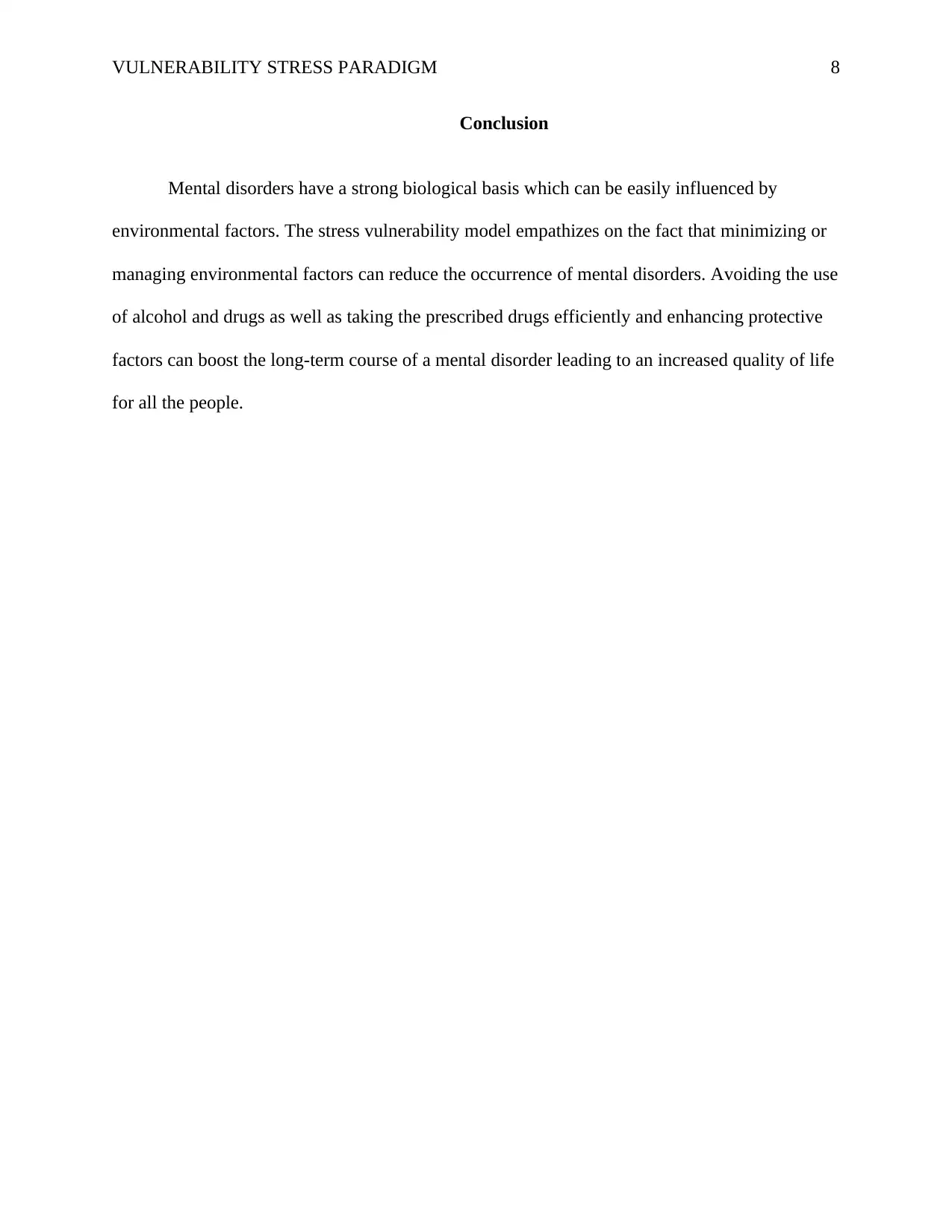
VULNERABILITY STRESS PARADIGM 8
Conclusion
Mental disorders have a strong biological basis which can be easily influenced by
environmental factors. The stress vulnerability model empathizes on the fact that minimizing or
managing environmental factors can reduce the occurrence of mental disorders. Avoiding the use
of alcohol and drugs as well as taking the prescribed drugs efficiently and enhancing protective
factors can boost the long-term course of a mental disorder leading to an increased quality of life
for all the people.
Conclusion
Mental disorders have a strong biological basis which can be easily influenced by
environmental factors. The stress vulnerability model empathizes on the fact that minimizing or
managing environmental factors can reduce the occurrence of mental disorders. Avoiding the use
of alcohol and drugs as well as taking the prescribed drugs efficiently and enhancing protective
factors can boost the long-term course of a mental disorder leading to an increased quality of life
for all the people.
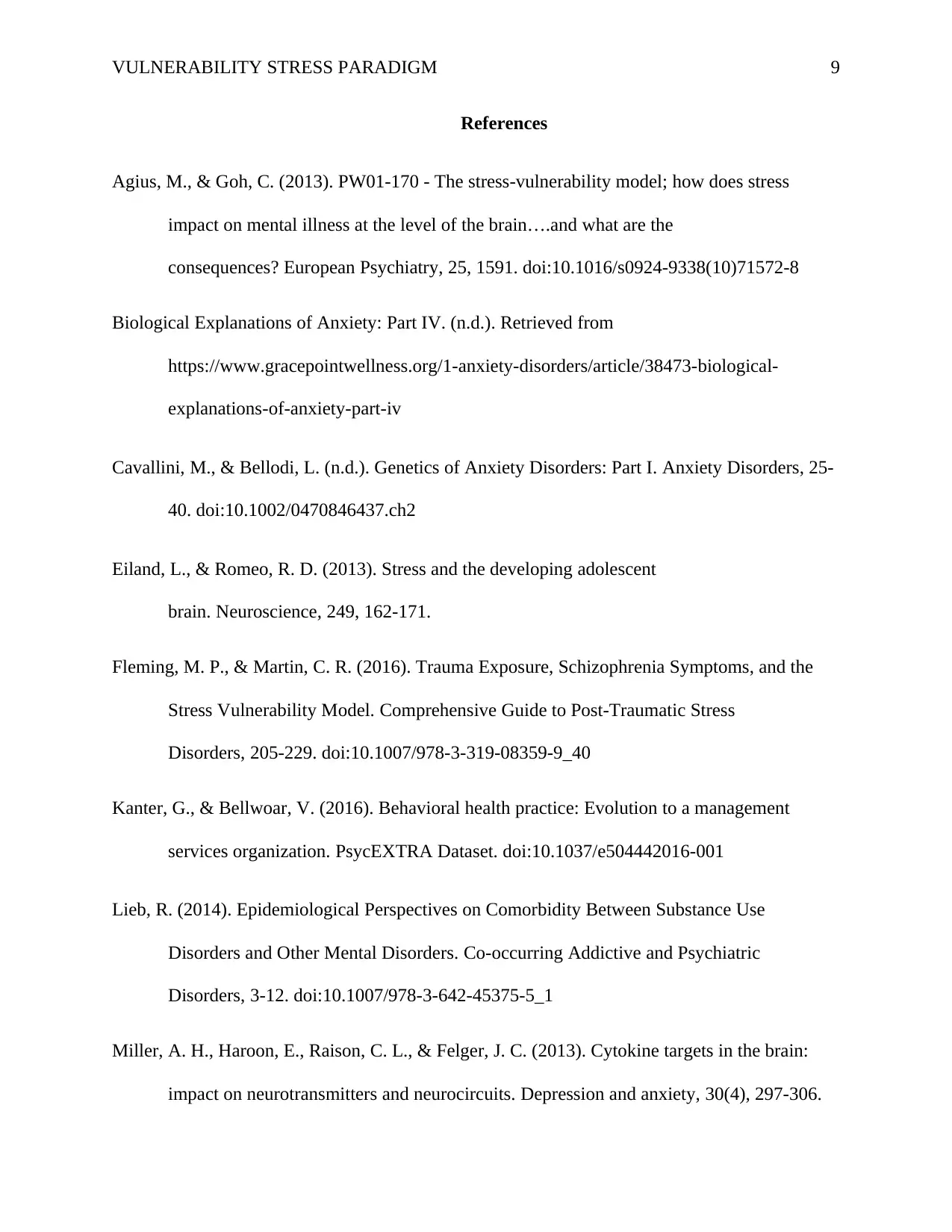
VULNERABILITY STRESS PARADIGM 9
References
Agius, M., & Goh, C. (2013). PW01-170 - The stress-vulnerability model; how does stress
impact on mental illness at the level of the brain….and what are the
consequences? European Psychiatry, 25, 1591. doi:10.1016/s0924-9338(10)71572-8
Biological Explanations of Anxiety: Part IV. (n.d.). Retrieved from
https://www.gracepointwellness.org/1-anxiety-disorders/article/38473-biological-
explanations-of-anxiety-part-iv
Cavallini, M., & Bellodi, L. (n.d.). Genetics of Anxiety Disorders: Part I. Anxiety Disorders, 25-
40. doi:10.1002/0470846437.ch2
Eiland, L., & Romeo, R. D. (2013). Stress and the developing adolescent
brain. Neuroscience, 249, 162-171.
Fleming, M. P., & Martin, C. R. (2016). Trauma Exposure, Schizophrenia Symptoms, and the
Stress Vulnerability Model. Comprehensive Guide to Post-Traumatic Stress
Disorders, 205-229. doi:10.1007/978-3-319-08359-9_40
Kanter, G., & Bellwoar, V. (2016). Behavioral health practice: Evolution to a management
services organization. PsycEXTRA Dataset. doi:10.1037/e504442016-001
Lieb, R. (2014). Epidemiological Perspectives on Comorbidity Between Substance Use
Disorders and Other Mental Disorders. Co-occurring Addictive and Psychiatric
Disorders, 3-12. doi:10.1007/978-3-642-45375-5_1
Miller, A. H., Haroon, E., Raison, C. L., & Felger, J. C. (2013). Cytokine targets in the brain:
impact on neurotransmitters and neurocircuits. Depression and anxiety, 30(4), 297-306.
References
Agius, M., & Goh, C. (2013). PW01-170 - The stress-vulnerability model; how does stress
impact on mental illness at the level of the brain….and what are the
consequences? European Psychiatry, 25, 1591. doi:10.1016/s0924-9338(10)71572-8
Biological Explanations of Anxiety: Part IV. (n.d.). Retrieved from
https://www.gracepointwellness.org/1-anxiety-disorders/article/38473-biological-
explanations-of-anxiety-part-iv
Cavallini, M., & Bellodi, L. (n.d.). Genetics of Anxiety Disorders: Part I. Anxiety Disorders, 25-
40. doi:10.1002/0470846437.ch2
Eiland, L., & Romeo, R. D. (2013). Stress and the developing adolescent
brain. Neuroscience, 249, 162-171.
Fleming, M. P., & Martin, C. R. (2016). Trauma Exposure, Schizophrenia Symptoms, and the
Stress Vulnerability Model. Comprehensive Guide to Post-Traumatic Stress
Disorders, 205-229. doi:10.1007/978-3-319-08359-9_40
Kanter, G., & Bellwoar, V. (2016). Behavioral health practice: Evolution to a management
services organization. PsycEXTRA Dataset. doi:10.1037/e504442016-001
Lieb, R. (2014). Epidemiological Perspectives on Comorbidity Between Substance Use
Disorders and Other Mental Disorders. Co-occurring Addictive and Psychiatric
Disorders, 3-12. doi:10.1007/978-3-642-45375-5_1
Miller, A. H., Haroon, E., Raison, C. L., & Felger, J. C. (2013). Cytokine targets in the brain:
impact on neurotransmitters and neurocircuits. Depression and anxiety, 30(4), 297-306.
⊘ This is a preview!⊘
Do you want full access?
Subscribe today to unlock all pages.

Trusted by 1+ million students worldwide
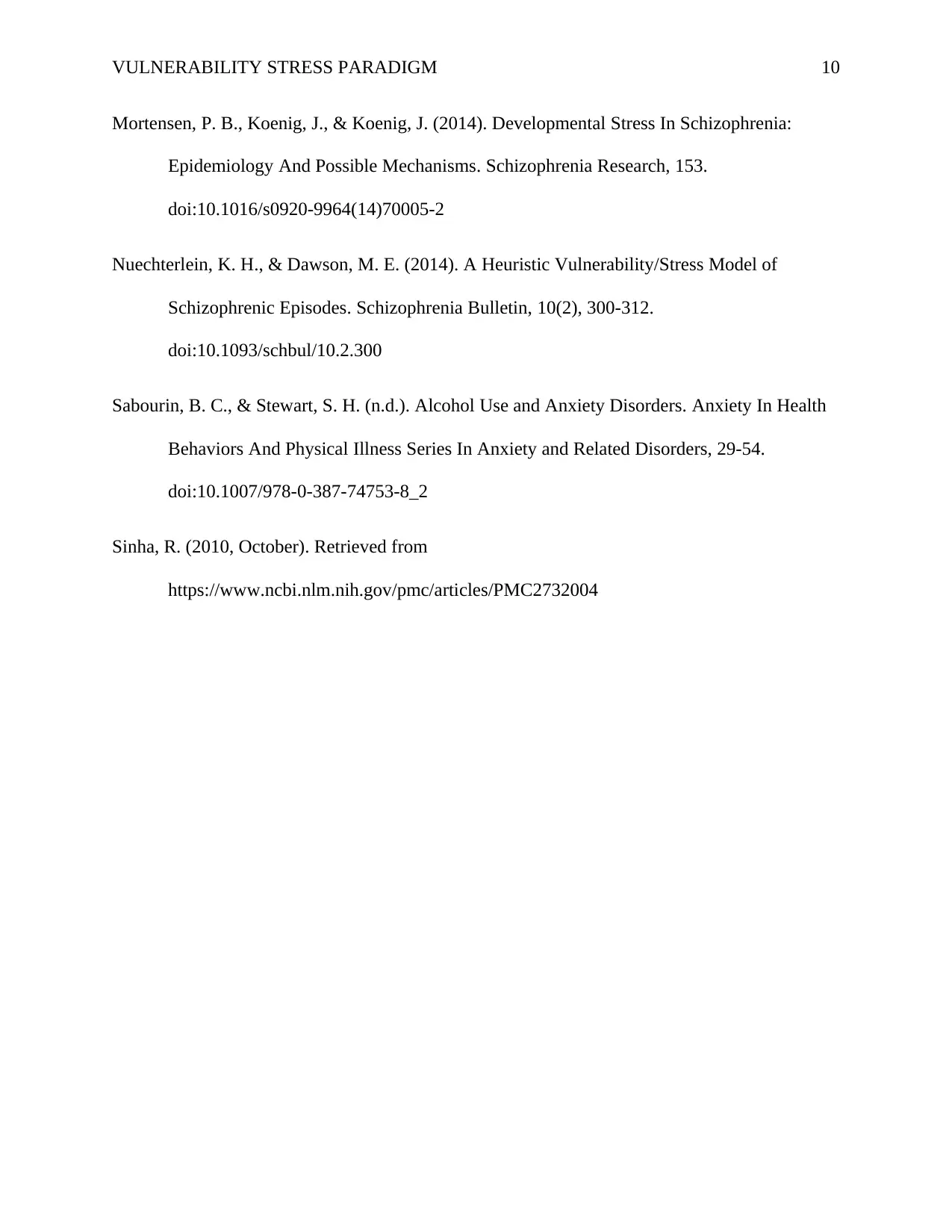
VULNERABILITY STRESS PARADIGM 10
Mortensen, P. B., Koenig, J., & Koenig, J. (2014). Developmental Stress In Schizophrenia:
Epidemiology And Possible Mechanisms. Schizophrenia Research, 153.
doi:10.1016/s0920-9964(14)70005-2
Nuechterlein, K. H., & Dawson, M. E. (2014). A Heuristic Vulnerability/Stress Model of
Schizophrenic Episodes. Schizophrenia Bulletin, 10(2), 300-312.
doi:10.1093/schbul/10.2.300
Sabourin, B. C., & Stewart, S. H. (n.d.). Alcohol Use and Anxiety Disorders. Anxiety In Health
Behaviors And Physical Illness Series In Anxiety and Related Disorders, 29-54.
doi:10.1007/978-0-387-74753-8_2
Sinha, R. (2010, October). Retrieved from
https://www.ncbi.nlm.nih.gov/pmc/articles/PMC2732004
Mortensen, P. B., Koenig, J., & Koenig, J. (2014). Developmental Stress In Schizophrenia:
Epidemiology And Possible Mechanisms. Schizophrenia Research, 153.
doi:10.1016/s0920-9964(14)70005-2
Nuechterlein, K. H., & Dawson, M. E. (2014). A Heuristic Vulnerability/Stress Model of
Schizophrenic Episodes. Schizophrenia Bulletin, 10(2), 300-312.
doi:10.1093/schbul/10.2.300
Sabourin, B. C., & Stewart, S. H. (n.d.). Alcohol Use and Anxiety Disorders. Anxiety In Health
Behaviors And Physical Illness Series In Anxiety and Related Disorders, 29-54.
doi:10.1007/978-0-387-74753-8_2
Sinha, R. (2010, October). Retrieved from
https://www.ncbi.nlm.nih.gov/pmc/articles/PMC2732004
Paraphrase This Document
Need a fresh take? Get an instant paraphrase of this document with our AI Paraphraser

VULNERABILITY STRESS PARADIGM 11
1 out of 11
Related Documents
Your All-in-One AI-Powered Toolkit for Academic Success.
+13062052269
info@desklib.com
Available 24*7 on WhatsApp / Email
![[object Object]](/_next/static/media/star-bottom.7253800d.svg)
Unlock your academic potential
Copyright © 2020–2025 A2Z Services. All Rights Reserved. Developed and managed by ZUCOL.





